Back when Philadelphia was home, I often frequented an all-you-can-eat sushi restaurant called Ajia located a few steps from the Schuylkill River. For just $21.95, my friends and I gorged until we burst on shrimp tempura rolls, all manner of nigiri, and unique-to-Philly creations like the sweet potato roll and “Rock N Roll” roll.
Though I tried my darnedest to get my money’s worth during these AYCE outings, I could never resist ordering a half dozen inari along with the usual sushi spread. These sweet fried tofu pouches filled with marinated rice were easily the least cost effective menu item, and worse yet, they sat in my stomach like a brick. I wasn’t being a savvy consumer, but I didn’t care because the inari were delicious.
While shopping for furikake and Sumo citrus at my neighborhood Mitsuwa the other weekend, the idea of making inari from scratch popped into my head. After finding a trusty recipe from JustJenn and collecting the ingredients missing from my pantry, I came home and made some for lunch.
This semi-homemade recipe came together quickly and most satisfactorily. Considering that the rice was prepared in a rice cooker and the tofu pouches were sold prefabbed, the only real work was measuring the dressing, toasting some sesame seeds, and assembling the whole package. Project inari proved to be so easy and satisfying that I’ll never again order it at a restaurant. And certainly not at an all-you-can-eat one!
- 1 1/2 cups uncooked sushi rice
- 1/4 cup rice vinegar
- 3/4 teaspoons salt
- 3 tablespoons sugar
- 1 package aburage (tofu pouches)
- 1 1/2 tablespoons white sesame seeds
Prepare rice according to the directions written on the package. I used my rice cooker, which was gifted to me by my mother when I graduated from college.
While the rice is bubbling and boiling away, whisk together the vinegar, salt, and sugar in a medium sized bowl and set aside. Dress the rice with this mixture as soon as it is cooked. Adjust the amount according to your preferences—use less for well-balanced rice, more for tangier rice.
Prepare tofu pouches according to the directions written on the package. The brand I used required boiling the pouches in their packaging for five minutes.
On a separate burner, lightly toast the sesame seeds until they are golden and nutty. Set aside.
To assemble, open the pouches, fill with seasoned rice, and sprinkle with sesame seeds. Serve straightaway.
Makes 12 inari sushi.
Recipe by JustJenn. [For Printable Recipe Click Here]
More vegetarian recipes on Gastronomy:
- Artichoke and Goat Cheese Strata
- Barley Risotto with Butternut Squash and Fried Sage
- Black Bean Burgers
- Cà Dê Nướng – Roasted Eggplant with Soy Sauce and Chilies
- Cinnamon Raisin Swirl Sandwich
- Dorie Greenspan’s Beggar’s Linguine – Pasta with Brown Butter, Dried Fruits, and Nuts
- Field Greens with Craisins, Mandarin Oranges, Goat Cheese & Balsamic Vinaigrette
- Frank Stitt’s Creamy Grits
- Hobak Jeon – Korean Zucchini Pancakes
- Jicama and Mandarin Orange Salad
- Lemony Haricot Verts
- No-Stir Butternut Squash, Rosemary & Blue Cheese Risotto
- Nước Chấm Chay – Vegetarian Vietnamese Dipping Sauce
- Old-Fashioned Potato Gratin
- Pasta with Caramelized Onions & Blue Cheese
- Phở Chay – Vegetarian Phở
- Roasted Beets
- Seared Gnocchi with Green Olive Sauce
- Tarragon Egg Salad
- Vegan Pesto Pasta
- Đậu Hũ Kho – Braised Tofu with Mushrooms and Tomatoes
- Đậu Hủ Xả Ớt – Fried Tofu with Chilies and Lemongrass

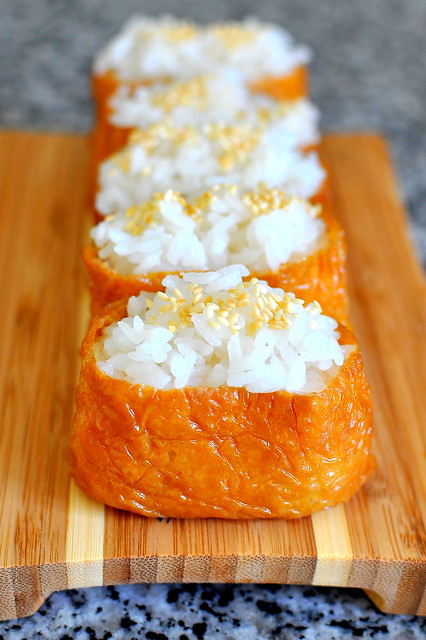

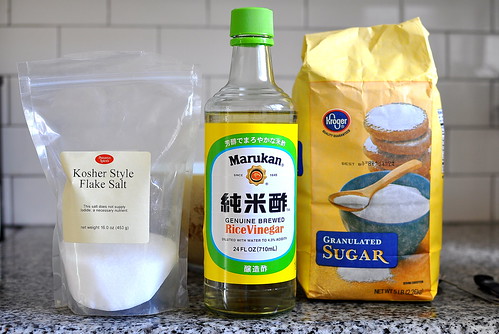
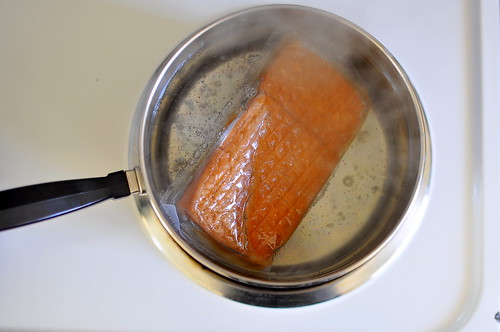
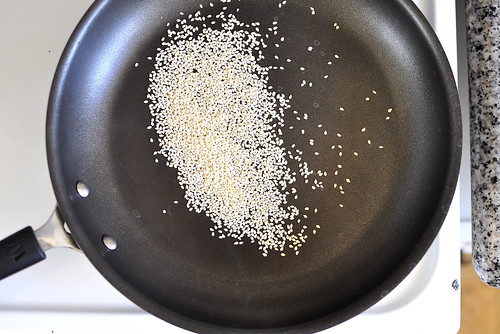
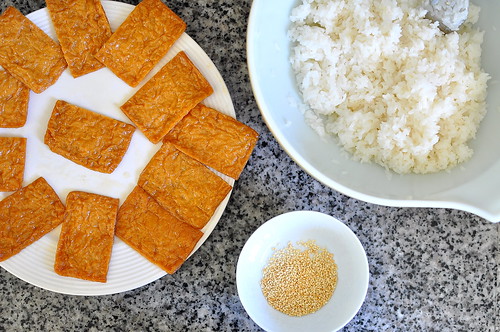
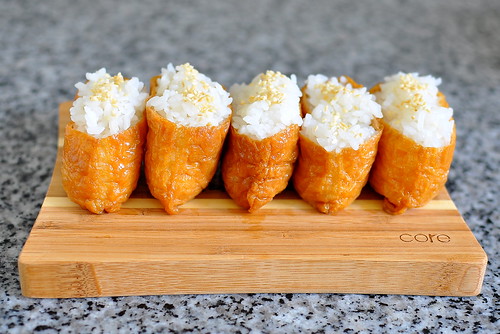
When I was a kid, my mom would make this all the time. My job was to fan the rice as she tossed it with the dressing to ensure that the rice would be shiny. No idea if this is true, I just know it was my job in the process. Still my favorite treat and greatest comfort food.
I just had homemade inari at a St. Patrick’s Day party (South Bay area, so inari totally normal) and it was amazing. BTW – I also lived right by the Schuylkill River, in King of Prussia, for a number of years!
Linda – So, that explains why my rice wasn’t shiny! Actually, I have no idea if that’s true, but I love that your mom included you in the inari making process when you were a kid. I think I’ll do the same if I ever have little ones 😉
Rachael – Inari IS amazing. And I can’t believe you lived by the Schuylkill River too. What are the chances? I heart Philly.
I love inari! This is what I judge a sushi place by because it is my favorite thing. If it is not on the menu, I don’t even want to go back a 2nd time.
Awww BUMMED I missed out on those little cool pockets! You know how I feel about tofu. 😉 Might have to attempt these bad boys on my own!
P.S. Sumo Citrus? Isn’t it the best??????
I’m very impressed with these open-top inari as I’m used to seeing the standard inari. They are unique and I wonder why nobody thought about this before. Thank you for sharing the recipe.
According to serious sushi chefs the fanning is really necessary. It has something to do with the evaporating vinegar coating each grain of rice. This process should also be done using something called a hangiri. This “tub” made of some kind of wood gives the rice a nice aroma.
Haha.I can never resist ordering these at AYCE places even though I know it’s cheap and filling and easy to make. They remind me of my childhood.
Ah, Philly. I live near Valley Forge and always have.
I’ve always wanted to try my hand at inari. They just look soooo good. Probably not the healthiest option, but now that they look so easy…
love Mitsuwa! these look yummy and remind me of Cham tofu pockets now I’m hungry!
I haven’t had these in ages! So glad I can make these at home. It’s a real money-saver!
Thank you for this recipe. I have not had this dish since I lived in Okinawa back in the 80’s. I always wanted to learn how to make this sushi.
Thanks.
Love these but next time you make it consider adding some cubed and boiled carrots…you cannot believe how much tastier they become (if such a thing is possible)
Thanks for the recipe! It’s on quite a few different websites…but you have pictures and that automatically makes that the best one yet! Thank you! I’ll now live off these!
I love them but where did you bought the tofu pouches? I live in LA ,CA and i have no idea where to buy them.
Daisy – Mitsuwa Marketplace (multiple locations) carry the pouches. I’m sure other Japanese grocery stores would too. It’s a fairly common product. Good luck!
I was very very astonished to look at the pictures. They are completely upside down of esatern Japanese inari-zushi! Of course I see, foreign people wouldn’t see they are sushi if making in Japanese way. Recipe itself is perfect!
When we lived in Okinawa during the late 70’s this was my favorite Okinawian treat. When we were transfered to the Chicago area in the 80’s. When visiting China Town in the city we saw these treats in a food display window. For the 3 1/2 years we were there we had anari and it was exactly like Okinawa. Going to try this
Hope it is the same.